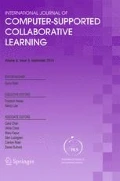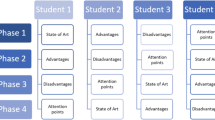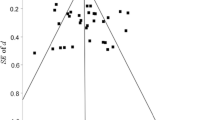Abstract
Macro scripts structure collaborative learning and foster the emergence of knowledge-productive interactions such as argumentation, explanations and mutual regulation. We propose a pedagogical model for the designing of scripts and illustrate this model using three scripts. In brief, a script disturbs the natural convergence of a team and in doing so increases the intensity of interaction required between team members for the completion of their collaborative task. The nature of the perturbation determines the types of interactions that are necessary for overcoming it: for instance, if a script provides students with conflicting evidence, more argumentation is required before students can reach an agreement. Tools for authoring scripts manipulate abstract representations of the script components and the mechanisms that relate components to one another. These mechanisms are encompassed in the transformation of data structures (social structure, resources structure and products structure) between script phases. We describe how this pedagogical design model is translated into computational structures in three illustrated scripts.









Similar content being viewed by others
References
Aronson, E., Blaney, N., Sikes, J., Stephan, G., & Snapp, M. (1978). The jigsaw classroom. Beverly Hills, CA: Sage.
Ayala, G., & Yano, Y. (1998). A collaborative learning environment based on intelligent agents. Expert Systems with Applications, 14, 129–137.
Baker, M. J. (1995). Negotiation in collaborative problem-solving dialogues. In R.-J. Beun, M. J. Baker, & M. Reiner (Eds.), Dialogue and instruction (pp. 39–55). Berlin: Springer.
Baker, M. J., & Lund, K. (1996). Flexibly structuring the interaction in a CSCL environment. In P. Brna, A. Paiva, & J. Self (Eds.), Proceedings of the European conference on artificial intelligence in education (pp. 401–407). Lisbon, Portugal: Edicoes Colibri Sept. 20–Oct. 2.
Barros, B., & Verdejo, M. F. (2000). Analysing student interaction processes in order to improve collaboration. The DEGREE approach. International Journal of Artificial Intelligence in Education, 11, 221–241.
Berger, A., Moretti, R., Chastonay, P., Dillenbourg, P., Bchir, A., Baddoura, R., et al. (2001). Teaching community health by exploiting international socio-cultural and economical differences. In P. Dillenbourg, A. Eurelings, & K. Hakkarainen (Eds.), Proceedings of the first European conference on computer supported collaborative learning (pp. 97–105). Maastricht, March 2001.
Betbeder, M. L, & Tchounikine, P. (2003). Symba: A framework to support collective activities in an educational context. In Proceedings of the international conference on computers in education (pp. 188–196), Hong Kong.
Blaye, A., Light, P., Joiner, R., & Sheldon, S. (1991). Collaboration as a facilitator of planning and problem solving on a computer based task. British Journal of Psychology, 9, 471–483.
Brousseau, G. (1998). Théorie des situations didactiques. Grenoble: La Pensée Sauvage.
Cherubini, M., & van der Pol, J. (2005). Grounding is not shared understanding: Distinguishing grounding at an utterance and knowledge level. In CONTEXT’05, the fifth international and interdisciplinary conference on modeling and using context, 2005.
Clark, H. H., & Wilkes-Gibbs, D. (1986). Referring as a collaborative process. Cognition, 22, 1–39.
Constantino-Gonzalez, M., & Suthers, D. (2000). A coached collaborative learning environment for Entity-Relationship modeling. In Proceedings of the 5th international conference on intelligent tutoring systems (pp. 324–333). Montreal: Canada.
De Jong, T., & van Jooligen (1998). Scientific discovery learning with computer simulations of conceptual domains. Review of Educational Research, 68, 179–202.
Dillenbourg, P. (2002). Over-scripting CSCL: The risks of blending collaborative learning with instructional design. In P. A. Kirschner (Ed.), Three worlds of CSCL. Can we support CSCL (pp. 61–91). Heerlen: Open Universiteit Nederland.
Dillenbourg, P., Baker, M., Blaye, A., & O’Malley, C. (1996). The evolution of research on collaborative learning. In E. Spada & P. Reiman (Eds.), Learning in humans and machine: Towards an interdisciplinary learning science (pp. 189–211). Oxford: Elsevier.
Dillenbourg, P., & Fischer, F. (2007). Basics of computer-supported collaborative learning. Zeitschrift für Berufs-und Wirtschaftspädagogik, 21, 111–130.
Dillenbourg, P., & Jermann, P. (2007). Designing integrative scripts. In F. Fischer, H. Mandl, J. Haake, & I. Kollar (Eds.), Scripting computer-supported collaborative learning––Cognitive, computational, and educational perspectives (pp. 275–301). New York: Springer Computer-supported Collaborative Learning Series.
Dillenbourg, P., Ott, D., Wehrle, T., Bourquin, Y., Jermann, P., Corti, D., et al. (2002). The socio-cognitive functions of community mirrors. In F. Flückiger, C. Jutz, P. Schulz, & L. Cantoni (Eds.), Proceedings of the 4th international conference on new educational environments. Lugano, May 8–11, 2002.
Dillenbourg, P., & Tchounikine, P. (2007). Flexibility in macro CSCl scripts. Journal of Computer Assisted Learning, 23(1), 1–13.
Dillenbourg, P., & Traum, D. (2006). Sharing solutions: persistence and grounding in multi-modal collaborative problem solving. Journal of the Learning Sciences, 15(1), 121–151.
Doise, W., & Mugny, G. (1984). The social development of the intellect. Oxford: Pergamon.
Friesen, M. (2005). Interoperability and learning objects: An overview of E-learning standardization. Interdisciplinary Journal of Knowledge and Learning Objects, 1, 23–30.
Gijlers, H., & de Jong, T. (2005). Confronting ideas in collaborative scientific discovery learning. Paper presented at AERA 2005, Montreal, CA.
Hoppe, U. H., & Ploetzner, R. (1999). Can analytic models support learning in groups? In P. Dillenbourg (Ed.), Collaborative-learning: Cognitive and computational approaches (pp.147–168). Oxford: Elsevier.
Inaba, A., & Okamoto, T. (1996). Development of the intelligent discussion support system for collaborative learning. In Proceedings of ED-TELECOM’96 (pp. 137–142). Boston, MA.
Inaba, A., Supnithi, T., Ikeda, M., Mizoguchi, R., & Toyoda, J. (2000). How can we form effective collaborative learning groups? In Proceedings of the 5th international conference on intelligent tutoring systems (pp. 282–291), June 19–23, 2000.
Jermann, P., & Dillenbourg, P. (2003). Elaborating new arguments through a CSCL scenario. In G. Andriessen, M. Baker, & D. Suthers (Eds.), Arguing to learn: Confronting cognitions in computer-supported collaborative learning environments (pp. 205–226). Amsterdam: Kluwer CSCL Book Series.
Jermann, P., & Dillenbourg, P. (2007). Group mirrors to support interaction regulation in collaborative problem solving. Computers and Education, in press.
Jermann, P., Dillenbourg, P., & Brouze, J. C. (1999). Dialectics for collective activities: An approach to virtual campus design. In Proceedings of the 9th international conference on AI in education. Le Mans, France, July 1999.
Jermann, P., Soller, A., & Mühlenbrock, M. (2001). From mirroring to guiding: A review of the state of art technology for supporting collaborative learning. In Proceedings of Euro-CSCL (pp. 324–331). Maastricht, NL.
Kobbe, L., Weinberger, A., Dillenbourg, P., Harrer, A., Hämäläinen, R., & Fischer, F. (2007). Specifying computer-supported collaboration scripts. International Journal of Computer-Supported Collaborative Learning, 2(2–3), 211–224.
McManus, M., & Aiken, R. (1995). Monitoring computer-based problem solving. Journal of Artificial Intelligence in Education, 6(4), 307–336.
Miyake, N. (1986). Constructive interaction and the iterative process of understanding. Cognitive Science, 10, 151–177.
Muehlenbrock, M. (2006). Learning group formation based on learner profile and context. International Journal on E-Learning, 5(1), 19–24.
O’Malley, C. (1987). Understanding explanation. Cognitive science research report no. CSRP-88. Great Britain: University of Sussex.
Palincsar, A. S., & Brown, A. L. (1984). Reciprocal teaching of comprehension-fostering and comprehension-monitoring activities. Cognition and Instruction, 1(2), 117–175.
Randolph, C. H., & Evertson, C. M. (1994). Images of management in a learner-centered classroom. Action in Teacher Education, 16(1), 55–65.
Ronen, M., Kohen-Vacs, D., Raz-Fogel, N. (2006). Structuring, sharing and reusing asynchronous collaborative pedagogy. In International conference of the learning sciences. Bloomington, IN: Indiana University.
Roschelle, J. (1990). Designing for conversations. Paper presented at the AAAI Symposium on knowledge-based environments for learning and teaching. Standford, CA, March 1990.
Roschelle, J., & Teasley, S. D. (1995). The construction of shared knowledge in collaborative problem solving. In C. E. O’Malley (Ed.), Computer-supported collaborative learning (pp. 69–197). Berlin: Springer.
Ross, L., Greene, D., & House, P. (1977). The false consensus phenomenon: An attributional bias in self-perception and social perception processes. Journal of Experimental Social Psychology, 13, 279–301.
Rummel, N., & Spada, H. (2007). Can people learn computer-mediated collaboration by following a script. In F. Fischer, H. Mandl, J. Haake, & I. Kollar (Eds.), Scripting computer-supported communication of knowledge. Cognitive, computational, and educational perspectives. New York: Springer CSCL Book Series.
Schwartz, D. L. (1995). The emergence of abstract dyad representations in dyad problem solving. The Journal of the Learning Sciences, 4(3), 321–354.
Soller, A. L. (2001). Supporting Social Interaction in an Intelligent Collaborative Learning System. International Journal of Artificial Intelligence in Education, 12(1), 40–62.
Suthers, D. (1999). Representational bias as guidance for learning interactions: A research agenda. In Proceedings of the 9th world conference on artificial intelligence in education (AIED‘97) (pp. 121–128). Le Mans, France, July 19–23, 1999.
Veerman, A. L., & Treasure-Jones, T. (1999). Software for problem solving through collaborative argumentation. In P. Coirier & J. E. B. Andriessen (Eds.), Foundations of argumentative text processing (pp. 203–230). Amsterdam: Amsterdam University Press.
Wasson, B. (1998). Identifying coordination agents for collaborative telelearning. International Journal of Artificial Intelligence in Education, 9, 275–299.
Weinberger, A., Fischer, F., & Mandl, H. (2002). Fostering computer supported collaborative learning with cooperation scripts and scaffolds. In G. Stahl (Ed.), Computer support for collaborative learning: Foundations for a CSCL community. Proceedings of the conference on computer support for collaborative learning (pp. 573–574). Boulder, CO.
Wessner, M., & Pfister, H. (2001). Group formation in computer-supported collaborative learning. In Proceedings of the 2001 international ACM SIGGROUP conference on supporting group work. Boulder, Colorado, USA, September 30–October 03, 2001.
Acknowledgments
This work was partly supported by the Swiss Center for Innovation in Learning (SCIL, University of St. Gallen) which is funded by the Gerbert Rüf foundation. Special thanks to SCIL members Taiga Brahm and Sabine Seufert. The paper was also supported by Kaleidoscope, a European Network of Excellence, in particular members of the MOSIL and COSSCILE groups, including Frank Fischer, Lars Kobbe, Armin Weinberger, Andreas Harrer, Nils Malzahn, Paivi Hakkinen, Raia Hamalainen, Sanna Jarvela, Ulrich Hoppe and Pierre Tchounikine. We also benefited from the contributions of our team members Shuja Parvez and Patrick Jermann and our former colleague Daniel Schneider.
Author information
Authors and Affiliations
Corresponding author
Rights and permissions
About this article
Cite this article
Dillenbourg, P., Hong, F. The mechanics of CSCL macro scripts. Computer Supported Learning 3, 5–23 (2008). https://doi.org/10.1007/s11412-007-9033-1
Received:
Accepted:
Published:
Issue Date:
DOI: https://doi.org/10.1007/s11412-007-9033-1




